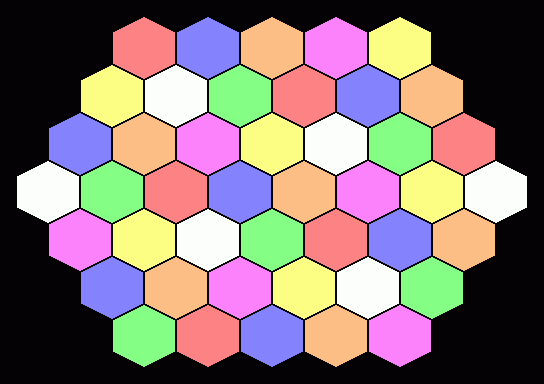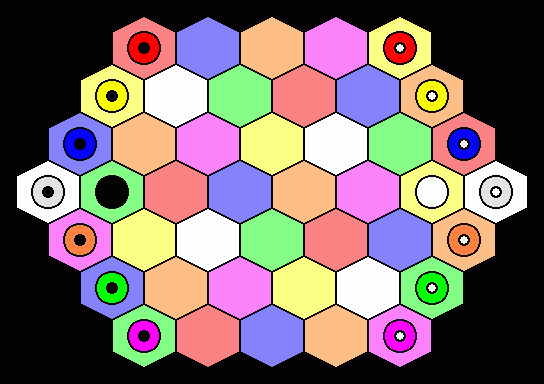Regenbogen
Regenbogen is a game played on the board shown below. It is played by two teams, Black and White, each with a very large stash of Icehouse pieces (or an equivalent set of other pieces), which are used to form the actual playing pieces. The players lead armies of Rainbow Wizards against each other in an attempt to Dominate the Spectrum.

When playing with Icehouse pieces, the following numbers are required:
- 2 Queens each of red, orange, yellow, green, blue, purple, and clear
- 1 Queen each of white and black
- 8 Drones each of red, orange, yellow, green, blue, and purple
- 4 clear Drones
- 11 Drones each of white and black
- 30 Pawns each of red, orange, yellow, green, blue, purple, white, and black
- 20 clear Pawns
Before play, give each player all of the pieces of their color (White or Black) and divide the remaining pieces evenly between the players.
In this game, each player has three types of pieces: Wizards, Clerics, and Spirits. A Wizard consists of any translucent Queen piece stacked on top of an opaque Drone. The color of the Queen determines the orientation of the Wizard, and the color of the Drone determines the owner. Clerics are opaque Queens, with color determining owner. A Spirit consists of a translucent Drone stacked on top of an opaque Pawn, similar to a Wizard but smaller. The colored Pawns (or in the case of Clerics, opaque Pawns) represent health and are stacked on top of the pieces which match their color. Finally, opaque Drones are also used to represent the Cleric's healing spells, and are stacked on Clerics but underneath their Health Pawns.
Setup
Before the game, assemble one Wizard of each color for each player, and give them five Health Pawns each. This represents six units of health (five Pawns plus the unit itself). Assemble a Cleric for each player, too, and give them four Health Pawns and four Spell Drones. Assemble the remaining colored Drones and opaque Pawns into four Spirits (except for Clear, for which there are two) for each player. Do not give them Health Pawns just yet; stack the remaining Health Pawns off-board with the Spirits. Then place the Wizards and Clerics on the board as shown below.

In this diagram, the colored circles with dots in them represent Wizards (dot color representing player), and the two solid circles are Clerics. (The reason this diagram uses circles instead of anything vaguely pyramidal is because while in development, the game was not meant to be an Icehouse game.) Clear Wizards, Spirits, and white spaces on the board have a special title, which replaces "clear" or "white"; that title is "Ultima."
Rules
White goes first. On your turn, you must move a piece, although in certain circumstances it is possible to move zero spaces. It is legal to move through spaces which are occupied by your own pieces, but not those which are occupied by your opponent. After moving, the player has the option of performing an action with the piece they just moved. An action may be one of the following:Fight. The piece does damage to an adjacent enemy piece. See below for damage details. If there are no adjacent enemy pieces, you may not use this action. When a piece is damaged, the correct number of Health Pawns is removed and returned to their owner's stash. If a piece takes damage greater than the number of Health Pawns it currently has, it is killed and removed from the board, unless the piece is a Cleric, in which case it can sacrifice a Spell Drone to stay alive. A player's Wizards' lost health must be kept separate from Spirit reserve health (see below).
Summon. Wizards only. A Spirit of the same color as the Wizard is placed on and adjacent vacant space and is given 3 Health Pawns. A player may have no more than 4 Spirits of one color, and the combined total Health Pawns of a single color of Spirits may be no more than 10 (with the exception of Ultima Spirits, of which a player may have only 2 and no more than 5 Health Pawns total). If you do not have at least 1 appropriate Spirit and 3 appropriate Health Pawns in reserve, or if the summoning space is the color opposite the Wizard's color in the spectrum (see below), you may not use this action.
Heal. Clerics only. The cleric forfeits a Spell Drone and recovers up to 2 Health Pawns to an adjacent friendly piece. The beneficiary may not, at any time, have more Health Pawns than they started with (so a Wizard may not have more than 5, and a Spirit, 3). Clerics may heal themselves if they move zero spaces. If your Cleric does not have any Spell Drones, you may not use this option.
Recover. Clerics only. The cleric stays in his current space and recovers a Spell Drone. If you move your Cleric more than zero spaces on your turn, or if your cleric is adjacent to any enemy pieces, or if your Cleric already has four Spell Drones, you may not use this option.
Self Destruct. Spirits only. The Spirit stays in its current space, damages all adjacent pieces, whether friendly or enemy, and is then removed from the board. If you move your Spirit on your turn, or if your Spirit has any Health Pawns, you may not use this option.
Attacking and the Spectrum
This game uses the spectrum of six colors (red, orange, yellow, green, blue, and purple) as a basic game mechanic. When a piece attacks another piece with an adjacent color (for example, when a green attacks a yellow, or a purple attacks a red), they do two damage. When a piece attacks a piece of the same color, they do zero damage. All other attacks do one damage. Ultima pieces are considered adjacent to every color, but other colors are not considered adjacent to it. Clerics always do one damage, regardless of the target, and always take two damage, regardless of who attacks them. If a piece is on the same color space while attacking, all their attacks do one more damage than normal.Movement
Each piece has its own movement value: Wizards 1, Spirits 2, and Clerics 3. When a player moves a piece, they may move it in a straight, orthogonal line a number of spaces equal to or less than the piece's movement value. A move may be of zero spaces if (and only if) the piece moving zero spaces has a valid action in their current space There are three exceptions to this rule.Exception 1. When a piece starts on a space of its own color, it may move one space beyond its movement value in any direction.
Exception 2. When a piece has a space of its own color that it may move to, it may move one space beyond its movement value in that direction only. In other words, a space of your color boosts your movement by one space.
Exception 3. No piece may move onto or through a space of the color opposite it in the spectrum. For example, an orange piece may never move onto or pass through a blue space. Ultima has no opposite, and Clerics may not move onto or through Ultima spaces.
Domination Conditions
A player may win by any of the following conditions:Ultima Domination. The player kills the opposing Ultima Wizard.
Triad Domination. The player kills three opposing Wizards which make a complete and continuous half of the spectrum.
Dual Domination. The player kills four opposing Wizards of two opposite pairs.
Primary Domination. The player kills the opposing red, yellow, and blue Wizards.
Secondary Domination. The player kills the opposing orange, green, and purple Wizards.
Notes
This game was inspired by the computer game Vantage Master Online, which in itself is loosely a Chess variant. It was originally going to be much more Vantage Master-oriented, but as time progressed it became more and more abstract until it eventually involved two armies of multicolored pyramids.
The word "Regenbogen" is German for "Rainbow." The idea for using the
word "Rainbow" in another language was kinda blatantly stolen from
Lítrof.
 This 'user submitted' page is a collaboration between the posting user and the Chess Variant Pages. Registered contributors to the Chess Variant Pages have the ability to post their own works, subject to review and editing by the Chess Variant Pages Editorial Staff.
This 'user submitted' page is a collaboration between the posting user and the Chess Variant Pages. Registered contributors to the Chess Variant Pages have the ability to post their own works, subject to review and editing by the Chess Variant Pages Editorial Staff.
By Jared B. McComb.
Last revised by Fergus Duniho.
Web page created: 2004-04-22. Web page last updated: 2022-02-17
